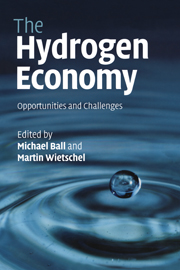Book contents
- Frontmatter
- Contents
- List of main contributors
- Preface
- Acknowledgements
- List of abbreviations
- 1 Scope of the book
- 2 Why hydrogen?
- 3 Non-renewable energy resources: fossil fuels – supply and future availability
- 4 Non-renewable energy resources: nuclear fuels
- 5 Assessment of the potentials for renewable energy sources
- 6 Carbon capture and storage
- 7 Energy-chain analysis of hydrogen and its competing alternative fuels for transport
- 8 Hydrogen today
- 9 Fundamental properties of hydrogen
- 10 Hydrogen production
- 11 Hydrogen storage
- 12 Hydrogen distribution
- 13 Key role of fuel cells
- 14 Hydrogen-infrastructure build-up in Europe
- 15 Building a hydrogen infrastructure in the USA
- 16 Hydrogen and the electricity sector
- 17 Hydrogen corridors
- 18 Macroeconomic impacts of hydrogen
- 19 Sustainable transport visions: the role of hydrogen and fuel-cell vehicle technologies
- 20 Energy-efficient solutions needed – paving the way for hydrogen
- 21 The future of hydrogen – opportunities and challenges
- Further reading
- Index
- References
3 - Non-renewable energy resources: fossil fuels – supply and future availability
Published online by Cambridge University Press: 22 January 2010
- Frontmatter
- Contents
- List of main contributors
- Preface
- Acknowledgements
- List of abbreviations
- 1 Scope of the book
- 2 Why hydrogen?
- 3 Non-renewable energy resources: fossil fuels – supply and future availability
- 4 Non-renewable energy resources: nuclear fuels
- 5 Assessment of the potentials for renewable energy sources
- 6 Carbon capture and storage
- 7 Energy-chain analysis of hydrogen and its competing alternative fuels for transport
- 8 Hydrogen today
- 9 Fundamental properties of hydrogen
- 10 Hydrogen production
- 11 Hydrogen storage
- 12 Hydrogen distribution
- 13 Key role of fuel cells
- 14 Hydrogen-infrastructure build-up in Europe
- 15 Building a hydrogen infrastructure in the USA
- 16 Hydrogen and the electricity sector
- 17 Hydrogen corridors
- 18 Macroeconomic impacts of hydrogen
- 19 Sustainable transport visions: the role of hydrogen and fuel-cell vehicle technologies
- 20 Energy-efficient solutions needed – paving the way for hydrogen
- 21 The future of hydrogen – opportunities and challenges
- Further reading
- Index
- References
Summary
Today, the world's energy supply still depends to around 90% on non-renewable energy sources, which are largely dominated by fossil fuels. As the global energy mix is widely expected to continue relying predominantly on fossil fuels in the coming decades, the question arises to what extent and how long fossil fuels will be able to sustain the supply. The projected increase in global energy demand, particularly in the developing nations of Asia (such as China and India), as well as the economic and geopolitical implications of future shortcomings in the supply of oil and gas, are already creating serious concerns about the security of energy supply. Especially, the transport sector, which is still almost entirely dependent on oil worldwide and would be most vulnerable to supply shortages, is increasingly triggering the search for alternative fuels. The following chapter thus focuses primarily on the future availability of fossil fuels in the context of the development of global energy demand and sets the scene for the possible introduction of hydrogen.
Projections on the future development of global energy demand
In the following, the past and future development of global energy demand and its composition will be briefly analysed. The energy balance methodology for primary energy demand of oil, gas, coal and biomass is normally based on the calorific content of the energy commodities.
- Type
- Chapter
- Information
- The Hydrogen EconomyOpportunities and Challenges, pp. 46 - 114Publisher: Cambridge University PressPrint publication year: 2009
References
- 3
- Cited by



